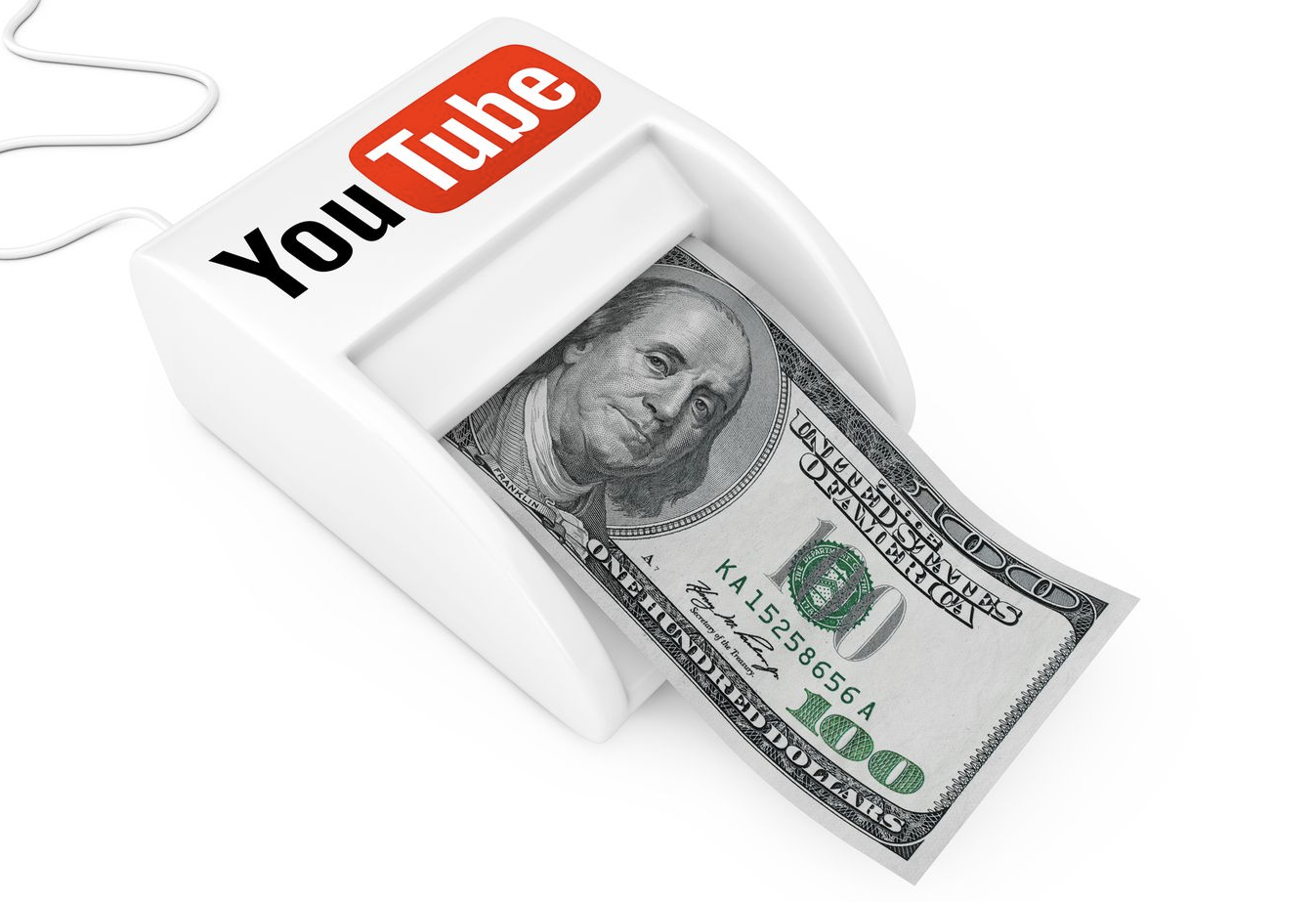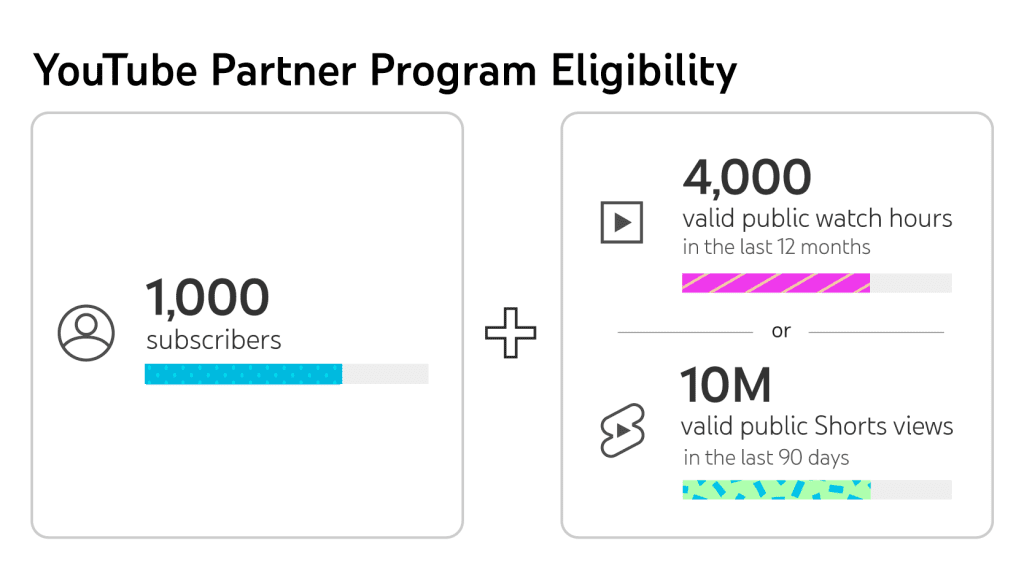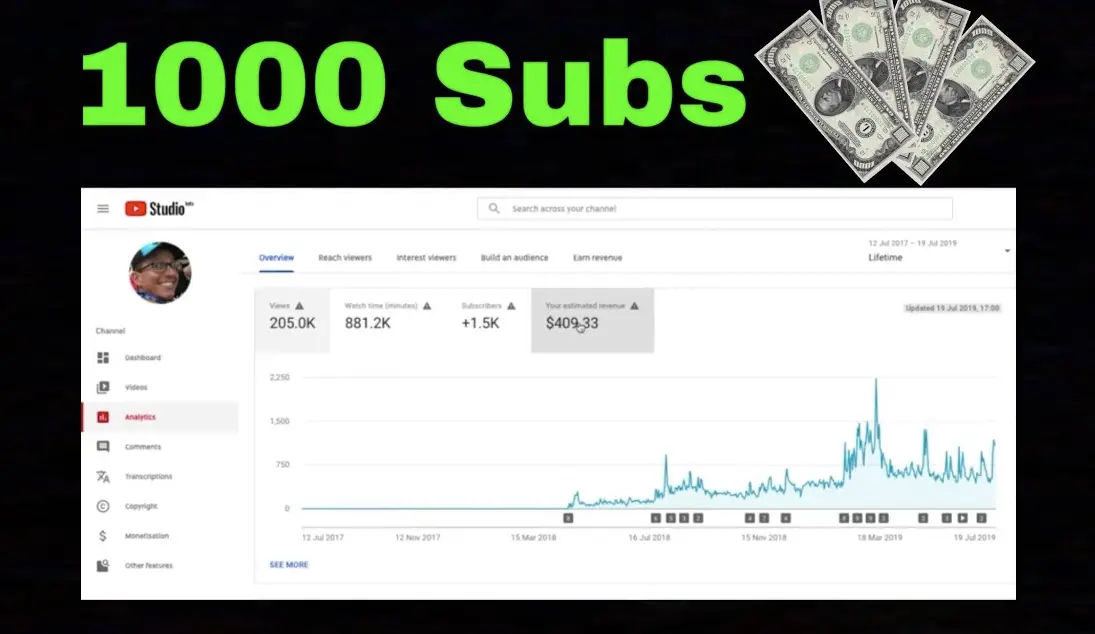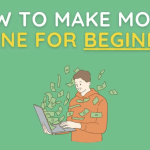I often earn from qualifying purchases. This includes Amazon Associates.
What kind of income can you generate from YouTube with 1,000 subscribers? It’s a question that lingers in the minds of many aspiring YouTubers.
The world of YouTube monetization can seem like an enigma to those standing at the threshold. Rest assured, YouTube monetization is far from mysterious.
Diving into this digital realm, one quickly realizes that subscriber count is just part of the equation. There are multiple factors contributing to your potential earnings on this platform.
In fact, understanding how much money you could make on YouTube with 1,000 subscribers requires a deeper look into various revenue streams and engagement metrics. Let’s unravel these together!
The Potential of YouTube as a Money-Making Platform
YouTube is more than just an entertainment platform. With over 2.5 billion users, YouTube is a lucrative platform for monetization and brand development.


YouTubers make money through various avenues like ad revenue, channel memberships set up by fans or businesses interested in sponsoring them. Modern-day social media influencers have harnessed these opportunities to create successful brands on the platform.
Earning Through Ad Revenue
One of the primary ways YouTubers earn money is via ad revenue from ads displayed on their videos. These can appear before or during video playback and come in different formats such as display ads or skippable video ads.
A viewer interacting with an ad or watching it for at least 30 seconds generates earnings for the creator. The level of audience engagement influences potential income – more views mean increased impressions and interactions which lead to higher revenues.
Leveraging Channel Memberships
In addition to advertising dollars, many YouTubers also increase their income stream by leveraging channel memberships. In exchange for monthly payments, members receive perks, badges, new emojis, exclusive live chats, and others depending on the membership levels offered by the creators themselves.
This direct financial support helps creators focus on producing quality content without worrying about generating enough views necessary for substantial Adsense revenues, while offering value-added benefits to loyal supporters simultaneously.
Selling Merchandise & Other Opportunities
Besides earning from advertisements and membership fees, another lucrative opportunity available through YouTube’s Partner Program includes selling merchandise directly under one’s videos using the YouTube Shopping feature. This allows millions to potentially view products related closely to the creator’s brand identity, boosting overall earnings significantly.
Paid sponsorships too offer additional ways how YouTubers make money once they’ve built substantial subscriber bases enjoying high engagement rates. Brands often approach popular channels looking to collaborate, thus providing yet another source of income outside the traditional methods provided by YouTube itself.
Unveiling the YouTube Partner Program
The YouTube Partner Program (YPP) is a crucial element in understanding how much money YouTubers make. It’s not just about creating engaging content and gathering subscribers, but also meeting specific requirements set by YouTube to become eligible for monetization.


To qualify for YPP, you need at least 1,000 subscribers on your channel. However, there are other factors to consider. Your videos must have accumulated over 4,000 valid public watch hours within the past year. This means people need to actively engage with your content – having a high subscriber count won’t suffice if those subscribers aren’t watching what you post.
In addition to these prerequisites, your channel needs adherence to all of YouTube’s policies and guidelines. Violating any rules can lead to disqualification from the program or even suspension of your account.
Navigating Through The Application Process
Once eligibility requirements are met, the next step is applying for YPP membership, which involves several steps: agreeing to the terms and conditions associated with the program, setting up an AdSense account for payment purposes, providing accurate contact information, and finally waiting for approval from YouTube after they review it against their policies.
This process may take some time depending upon various factors like the volume of applications received by YouTube during that period, the complexity involved in reviewing certain channels due to their nature/content, etc., so patience is key here.
Diversifying Income Streams With Monetization Features
Becoming a member opens multiple avenues through which YouTubers can earn from their content – primarily through ad revenue generated when ads are displayed alongside their videos, including pre-roll and post-roll advertisements.
Apart from the traditional form of earnings derived via the advertising model, members gain access to features such as Channel Memberships, where viewers pay a monthly fee to support creators in exchange for exclusive perks and benefits provided by the creators themselves. Another feature, Super Chat, allows fans to donate directly during live streams to show appreciation for the work done, thereby contributing an additional income stream for the creators. These features help diversify income sources and reduce dependency solely
How Ad Revenue Contributes to YouTube Earnings
YouTubers make money in a variety of ways, one of the most significant being ad revenue. Ads that appear before or during videos are not just interruptions for viewers; they’re income generators for creators.
The amount YouTubers earn from these ads can fluctuate based on factors such as the type and location of an ad, along with who is viewing it. On average, though, YouTubers receive about $0.018 per view from ads, which equates to approximately $18 for every 1,000 views.
Understanding Google AdSense Revenue Sharing
A key factor in the revenue generation process is Google’s AdSense platform. It forms the backbone through which advertisers pay creators when their advertisements get clicked or watched completely by users on YouTube channels.
In essence, advertisers set up budgets within Google Ads determining how much they wish to spend each time someone interacts (clicks/views) with their advertisement placements across various platforms, including YouTube channels. This payment then gets divided between both parties involved – roughly around 68% goes towards channel owners while the remaining funds are retained by Google itself under what’s known as the ‘revenue share’ model implemented by them.
This means that even if your YouTube channel has only managed to attract a modest number of subscribers, say like a thousand, but manages to garner high-quality traffic (viewers likely engage with displayed advertisements), you stand a chance of earning decent sums over a period purely via revenues generated through displaying adverts alone.
Decoding YouTube Earnings: Money Made with 1,000 Subscribers
The income potential of a YouTube channel is not solely dependent on the number of subscribers. Other elements such as video views and audience engagement are essential in deciding how much money you can make.
Mainly, YouTubers earn from ad revenue generated when viewers interact or watch ads embedded in their videos. However, it’s essential to understand that all views are not created equal; only ‘monetized playbacks’ contribute towards your earnings.
Ad Rates & Video Views: The Driving Forces
A successful YouTube channel doesn’t necessarily need thousands of subscribers but rather thousands of views per video for substantial earning through ad revenues. For instance, if you have around 1K subscribers and average about 500-600 views per video – your earning might be lower than someone who consistently garners more than a thousand view counts despite having fewer subs.
This fact underscores why focusing merely on subscriber count isn’t an accurate measure for financial success on this platform; instead, what matters most are high view counts coupled with strong viewer engagement rates.
In terms of advertising payments, YouTube operates via an auction system where advertisers bid different amounts based upon various aspects like target demographics, etc. This results in variations within CPM (Cost Per Thousand Impressions) across similar channels, thereby affecting overall revenues significantly.
Potential Earnings From Ad Revenue
To provide rough estimates – considering $18 as the average earnings per thousand monetizable impressions (CPM), theoretically speaking, every thousand monetizable plays could potentially generate approximately $18 before any deductions, including YouTube’s cut, which stands at roughly forty-five percent.
Please note these numbers fluctuate greatly due to varying CPMs along with other aforementioned factors; hence, they should serve merely as a ballpark figure rather than a definitive calculation predicting exact YouTube earnings.
Diversifying Your Income Streams
Last but certainly not least – while advertisements form the backbone of the majority of YouTube incomes, relying solely upon them might prove risky, especially given ever-changing algorithms plus unforeseen circumstances like demonetization risks
Exploring Other Monetization Options on YouTube
Beyond the traditional ad revenue, a plethora of monetization options are available for YouTubers. These methods offer an opportunity to diversify income streams and build financial stability.
Leveraging Channel Memberships
The channel memberships feature provides YouTubers with a steady stream of income by offering viewers exclusive benefits in exchange for monthly payments. The perks can range from unique badges and emojis to members-only videos.
Your earnings through this method largely depend on your ability to attract subscribers willing to pay for these additional features. Providing high-value content coupled with enticing membership perks increases the likelihood of gaining paying members, thereby boosting your overall YouTube earnings.
Using Super Chat & Super Stickers Effectively
YouTubers also have access to innovative features like Super Chat and Super Stickers during live streams, which not only enhance viewer engagement but also provide another avenue for earning money on YouTube. When viewers purchase chat messages or stickers, it amplifies their visibility amidst bustling chats while contributing towards creators’ incomes as well – 70% goes directly into the pockets of video creators.
To maximize this source’s potential, it is crucial that every super chat or sticker be acknowledged during live sessions, creating more incentive among audience participation and hence increasing revenues over time. More about ‘Super Thanks’.
The Power Of ‘Super Thanks’
‘Super thanks’, akin to a virtual tip jar, allows fans to show appreciation towards their favorite YouTuber’s contributions, making them feel valued and building stronger bonds between creator and audience, apart from adding direct monetary support – ranging from $1 to $500 per transaction.
Benefiting From YouTube Premium Revenue
In addition to ads, viewer contributions via super thanks/chat/sticker and YouTube premium subscriptions significantly contribute to enhancing a YouTuber’s total earnings. More About YT Premium Subscriptions
Premium subscription fees collected by YouTube get shared amongst video creators based on how much time premium subscribers spend watching relative to others’. Hence, increased user engagement metrics result in higher shares from premium revenues, substantially contributing to
Making Money through Affiliate Marketing
Affiliate marketing offers a viable income stream for YouTubers. This strategy involves endorsing products or services that align with your content and earning commissions from sales made via referral links.
Transparency is key in affiliate marketing: you should always disclose to viewers when you’re using affiliate links. Now, let’s delve into the steps involved in making money on YouTube through this method.
Selecting Products That Match Your Niche
The first step is choosing relevant products to promote. These should resonate with both your brand image and audience interests. For instance, if you have a tech-focused channel, it would make sense to recommend gadgets or software applications.
Promoting items that genuinely appeal to you will likely strike a chord with subscribers more than promoting random high-commission products just for the sake of earnings.
Finding Suitable Affiliate Programs
After identifying suitable merchandise, look out for their respective affiliate programs. Many companies run their own schemes; however, there are also platforms like eBay Partner Network, which aggregates multiple brands under one roof – an ideal starting point especially for beginners.
Besides these popular networks, consider specialized ones such as CJ Affiliate or ShareASale depending on what fits best within your niche content area.
Promoting Affiliated Links Effectively
The next challenge lies in strategically incorporating affiliated links without negatively disrupting the viewer experience. One approach could be integrating them naturally within video descriptions where users often seek additional information after watching videos.
Another effective tactic includes creating dedicated review videos showcasing the specific recommended product’s real-life utility, thereby subtly encouraging purchases through affiliated links while providing value simultaneously.
Craft SEO Optimized Content
To drive traffic towards those videos containing your associated links, you need well-crafted titles, tags, and descriptions. The use of appropriate keywords related to your content can help improve visibility, resulting in higher potential revenue.
Analyzing Performance & Refining Strategy
Your journey doesn’t end at posting linked content
Decoding YouTube Earnings: Money Made with 1,000 Subscribers
Uncover the potential earnings on YouTube with 1,000 subscribers. This post delves into monetization strategies to maximize your YouTube income.
The Role Of Paid Sponsorships In Boosting Earnings
As the YouTube channel grows and engagement rates increase, another avenue of income becomes accessible – paid sponsorships. This is a strategy where companies pay creators to promote their products or services within their content.
Sponsorship deals can be extremely profitable, particularly for channels with large audiences. However, it’s not just about numbers; the quality of your audience matters too. Brands are interested in influencers whose followers match their target demographic.
Finding The Right Sponsors
To identify sponsors that fit with your brand’s image and values on YouTube, you must have an understanding of who is in your audience and what types of items or services they would be interested in.
You could start by directly reaching out to businesses you believe would be suitable for sponsorship opportunities on your channel. There are also platforms available which connect YouTube creators with advertisers looking for influencer marketing partnerships.
Negotiating Your Sponsorship Deal
- Once potential sponsors have been identified, negotiation begins.
- Influencing factors such as the size of the audience, engagement rate, video views count, along with relevance, play a crucial role in determining how much money YouTubers make from these deals.
- To ensure fair compensation, consider using an online tool like Social Bluebook. This platform provides suggested pricing based on various metrics, including the number of subscribers, etc.
Maintaining Authenticity While Promoting Sponsored Content
- Paid promotions should always feel natural and authentic to maintain trust between the creator and the viewership.
- Audiences appreciate transparency, hence clearly disclose any sponsored content within videos, adhering to FTC guidelines.
Learning From Top Paid YouTubers
The path to YouTube success is often paved with lessons from those who have already climbed the ranks. By studying top paid YouTubers, you can glean valuable insights into growing your channel and maximizing earnings.
Consider Ryan Kaji of Ryan’s World, a young influencer who earned $29.5 million in 2023 alone. His income primarily comes from licensing deals for over 5000 branded products that span across various categories.
Focusing on Content Strategy
Ryan’s content strategy centers around crafting engaging videos aimed at his primary audience – children. He merges entertainment with education, which results in content appreciated by both kids and their parents alike.
This approach has led to an exponential increase in subscribership on his channel, directly impacting ad revenue potential through Google AdSense, as well as other monetization options like Super Chat & Super Stickers offered by YouTube’s partner program. YouTube Partner Program Policies.
Leveraging Merchandise Sales
Beyond ad revenues, merchandise sales significantly contribute to Ryan’s earnings too. The ‘Ryan’s World’ brand resonates strongly among its target demographic, leading it to now include toys, clothing lines, video games, amongst others, sold by major retailers worldwide. This demonstrates how effectively leveraging the YouTube Shopping feature not only leads to direct profits but also enhances one’s brand value substantially over time.
Paid Sponsorships And Partnerships
In addition to these sources of income, another lucrative source of earning money on YouTube involves partnerships with brands. These collaborations offer mutually beneficial relationships where creators get financial support while brands gain exposure through influencer marketing campaigns targeting millions of dedicated followers across social media platforms. This highlights the importance of building strong viewer engagement metrics to attract big-name sponsors willing to pay premium rates to access a subscriber base.
In conclusion, understanding the avenues for generating revenue is key to achieving substantial earnings on the platform. While AdSense remains a fundamental part of the equation, additional methods such as affiliate marketing, selling merchandise, setting up and using features like Super Chat, stickers, and memberships should not be overlooked. Moreover, studying the strategies implemented by successful You
Conclusion
Understanding the potential of YouTube as a money-making platform opens up new avenues for income generation.
The YouTube Partner Program, with its specific requirements, is your ticket to start earning on this platform.
Ad revenue contributes significantly to a YouTuber’s earnings – even if you only have 1,000 subscribers!
Beyond ads, there are other monetization options like channel memberships and super chat features that can boost your income.
Affiliate marketing and selling merchandise also present profitable opportunities when done right.
Paid sponsorships can give an impressive lift to your earnings once you’ve built a substantial subscriber base.
Inspiration from top paid YouTubers shows us how these strategies can be harnessed effectively for maximum returns.
If you’re ready to dive into the world of YouTube monetization or want more tips on side hustles and finance management, check out our project Money Empire. We provide valuable insights on saving money, business strategies, SEO tactics, and much more! Start maximizing your online earnings today!
Amazon and the Amazon logo are trademarks of Amazon.com, Inc, or its affiliates.






